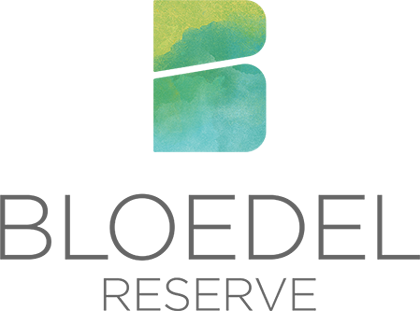Field Notes 2022: Naomi Cohn
October 2022: Naomi Cohn
Bloedel Reserve, in its 150 acres, has only so many paths. Yet it offers an infinity of walks. During my time there last fall, it was the perfect playground for my current project, Life List, a series of prose poems, flash essays and drawings about vision loss and reclaiming relationships with art-making and the rest of the natural world, through the lens of my obsession with birds.
Some of my own walks at Bloedel were research for this project. Bloedel was full of birds. So every walk was a collecting trip of sensory impressions of birds:
• the hoarse calls of ravens,
• the loud carpentry of Pileated Woodpeckers sculpting the trees with their hammer-heads,
• the rustle of a shrub full of invisible songbirds,
• the whittering of the wigeons as they circled the bird marsh or worked their way across a more manicured pond’s edge
• the silly call of eagles circling high over the mansion,
• the tiny specks of cormorants and loons and scoters captured by the generous zoom capacity of my digital camera.
At night there were the Barred Owls, their conversations often drowned out by the energetic choral jam sessions of the coyotes. Sometimes the coyotes couldn’t wait until dark, so intense was their need to sing.
…
The poet A. R. Ammons compared a poem to a walk . One of the connections he drew is the way both walks and poems are essentially, inextricably, embodied experiences.
Also like a poem, every walk at Bloedel had a little turn in it—the coyote trotting across the sheep meadow the afternoon I arrived, its coat sooty against the smoky air. Or that surprise of a tiny shrew, a velvety scrap of moving energy against the immensity of a tree, moss-covered roots a whole day’s journey to the short-lived hunter, who must eat every hour or die.
Each walk, even over the exact same path is unique: The wonder of time unfolding. The same path walked in the morning might have an entirely different character in the afternoon. During my weeks at Bloedel fall unfolded from the weathered greens of a dry smoky late summer to rain-revived mosses and fungus under the almost-neon evolution of colors in the maples dotting the landscape.
And of course, when I say walk, I also mean not walking—-stopping to pet some moss or sit on a bench and stare at the changing light. Or talking to people—staff, visitors, volunteers—met on the path. Everyone offers a favorite spot or species or bit of lore—about the Bloedels or how to help a new patch of moss get a good start or how fall-yellow Katsura tree leaves smell like burnt sugar.
We can also flip the poem-as-walk comparison on its head. A walk can be a poem. A poem after all is a creation, a “made thing” (from the Greek poesis.) At Bloedel the poem is crafted from the arrangement and tending of living things.So each walk around Bloedel can reflect back at us and our own creative work. Whatever our medium, whatever our subject, whatever stage of our creative process, a walk at Bloedel has something to offer us. For example, puzzling over revising something, I’d walk a Bloedel path and be inspired by the subtle edits of nature all around me. Of course, there is the pacing—the alternation of naturalistic and obviously composed gardens. But also, I’d notice:
• the way the path, its give underfoot, makes your leg want to take another step
• the way that grove of birches gleams particularly brightly when the sun catches it—has someone peeled away the older, rougher bark?
• the careful toupee of moss laid on a recently downed tree
All of this brings me back to my writing refreshed, inspired to shape it differently, tend to each detail, all without taking away from the organic life of the words. All of this shows me how Bloedel is also, in the best possible sense, a made thing. A constantly tended, ever-evolving creation. A poem.
SIGN UP FOR OUR ENEWSLETTER
Stay up to date on all of the events and activities taking place at Bloedel Reserve.

